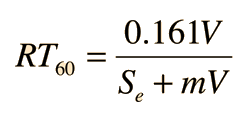Table of Absorption Coefficients
| Nature of surface | Sound Absorption Coefficients at Frequency(Hz) |
| 125 | 250 | 500 | 1000 | 2000 | 4000 |
| Acoustic tile, rigid mount | 0.2 | 0.4 | 0.7 | 0.8 | 0.6 | 0.4 |
| Acoustic tile, suspended | 0.5 | 0.7 | 0.6 | 0.7 | 0.7 | 0.5 |
| Acoustical plaster | 0.1 | 0.2 | 0.5 | 0.6 | 0.7 | 0.7 |
| Ordinary plaster, on lath | 0.2 | 0.15 | 0.1 | 0.05 | 0.04 | 0.05 |
| Gypsum wallboard, 1/2" on studs | 0.3 | 0.1 | 0.05 | 0.04 | 0.07 | 0.1 |
| Plywood sheet, 1/4" on studs | 0.6 | 0.3 | 0.1 | 0.1 | 0.1 | 0.1 |
| Concrete block, unpainted | 0.4 | 0.4 | 0.3 | 0.3 | 0.4 | 0.3 |
| Concrete block, painted | 0.1 | 0.05 | 0.06 | 0.07 | 0.1 | 0.1 |
| Concrete, poured | 0.01 | 0.01 | 0.02 | 0.02 | 0.02 | 0.03 |
| Brick | 0.03 | 0.03 | 0.03 | 0.04 | 0.05 | 0.07 |
| Vinyl tile on concrete | 0.02 | 0.03 | 0.03 | 0.03 | 0.03 | 0.02 |
| Heavy carpet on concrete | 0.02 | 0.06 | 0.15 | 0.4 | 0.6 | 0.6 |
| Heavy carpet on felt backing | 0.1 | 0.3 | 0.4 | 0.5 | 0.6 | 0.7 |
| Platform floor, wooden | 0.4 | 0.3 | 0.2 | 0.2 | 0.15 | 0.1 |
| Ordinary window glass | 0.3 | 0.2 | 0.2 | 0.1 | 0.07 | 0.04 |
| Heavy plate glass | 0.2 | 0.06 | 0.04 | 0.03 | 0.02 | 0.02 |
| Draperies, medium velour | 0.07 | 0.3 | 0.5 | 0.7 | 0.7 | 0.6 |
| Upholstered seating, unoccupied | 0.2 | 0.4 | 0.6 | 0.7 | 0.6 | 0.6 |
| Upholstered seating, occupied | 0.4 | 0.6 | 0.8 | 0.9 | 0.9 | 0.9 |
| Wood seating, unoccupied | 0.02 | 0.03 | 0.03 | 0.06 | 0.06 | 0.05 |
| Wooden pews, occupied | 0.4 | 0.4 | 0.7 | 0.7 | 0.8 | 0.7 |
Data from Hall, 2nd. Ed., Table 15.1
|
Index
Auditorium acoustics
Reference
Hall |




